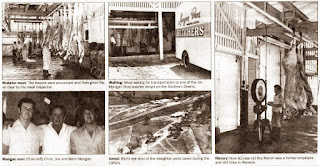MANGAN'S BUTCHERY
Clarrie, Joe and Bernie were the Mangan Brothers, all three of them having followed their father Thomas Joseph Mangan into the butchery trade.
Thomas and his wife Margaret (nee Reynolds) married in Victoria in 1912 and went on to have five children. Clarrie (Clarence James) was born in Wagga Wagga in 1913, followed by Joe (Joseph Thomas) in 1915. Ann was born in Murrumburrah in 1916, Mary in Junee in 1919, and finally Bernie (Bernard Vincent) in Sydney in 1922.
The peripatetic Mangan family arrived in Queensland at the height of the Great Depression and, in April 1932, Thomas acquired the butchering business of Carey and Howell. However, the business did not prosper and, within two years, Thomas had moved from Warwick, leaving his family with five pounds and a mortgage.
To support their mother and siblings, Clarrie and Joe (barely out of their teens) stepped in to run the business, operating it as Mangan Brothers. They worked as butchers during the day and, at night, built their cattle and sheep yards and state-of-the-art slaughterhouse on a 150-acre site in Rose Street, installing a killing floor, cold rooms and a machine room. A steam-operated by-products plant, powered by wood-fired boilers, was a further development. The digestion plant consisted of product cookers, centrifuges and hammer mills as well as tallow vats and a hide drying floor.
Although the business was short-handed when the youngest Mangan, Bernie, enlisted in the AIF in World War II, the War was a great boost to the fledgling enterprise because of the influx of service personnel. The Queensland Echelon and Records Office of the Australian Army was based in the Barnes Building (cnr King and Palmerin Sts) from March 1942 to September 1945, with 1,500 personnel working there at its peak. Mangan Brothers would eventually own five butcher shops in Warwick and one in Allora. By 1954, their meatworks supplied all but three Warwick butchers and, in the early 1960s, the construction camp for Leslie Dam.
Clarrie and Joe married and raised their families in Warwick while Bernie married and moved to Sydney after their father's death in 1953. Clarrie died in 1981, followed in 1983 by Joe and Bernie, but just the year before Clarrie’s death, the family sold the meatworks to Stuart Wade. It was later acquired by John Dee Abattoir.
in 2021, the building that housed Mangan’s butcher shop in Fitzroy St is still there, as is the adjacent Mangan’s Building, but on the evening of 17 November 2010, the meatworks was destroyed by fire when lightning struck a nearby transformer. Almost a dozen fire crews attended the blaze, but were unable to save the building. Parts of the by-products plant remain on the site and are visible from Rosehill Road.
Both Mangan sisters took vows with the Sacred Heart order. Mary became a respected infant teacher as Sister Mary Mercia while Ann, as Sister Mary Frederick, dedicated her life to Northern Territory Indigenous communities on Bathurst Island from the early 1950s and in Port Keats (Wadeye) in the 1970s. Much admired and loved by the communities she served, “Freddie” died and was buried on Bathurst Island and was honoured with a traditional smoking ceremony. In Port Keats, she was known affectionately as “One Gear” because of the determined fashion in which she drove her little ute around the mission, seldom bothering to change gears before arriving at her destination.
Thomas and his wife Margaret (nee Reynolds) married in Victoria in 1912 and went on to have five children. Clarrie (Clarence James) was born in Wagga Wagga in 1913, followed by Joe (Joseph Thomas) in 1915. Ann was born in Murrumburrah in 1916, Mary in Junee in 1919, and finally Bernie (Bernard Vincent) in Sydney in 1922.
The peripatetic Mangan family arrived in Queensland at the height of the Great Depression and, in April 1932, Thomas acquired the butchering business of Carey and Howell. However, the business did not prosper and, within two years, Thomas had moved from Warwick, leaving his family with five pounds and a mortgage.
To support their mother and siblings, Clarrie and Joe (barely out of their teens) stepped in to run the business, operating it as Mangan Brothers. They worked as butchers during the day and, at night, built their cattle and sheep yards and state-of-the-art slaughterhouse on a 150-acre site in Rose Street, installing a killing floor, cold rooms and a machine room. A steam-operated by-products plant, powered by wood-fired boilers, was a further development. The digestion plant consisted of product cookers, centrifuges and hammer mills as well as tallow vats and a hide drying floor.
Although the business was short-handed when the youngest Mangan, Bernie, enlisted in the AIF in World War II, the War was a great boost to the fledgling enterprise because of the influx of service personnel. The Queensland Echelon and Records Office of the Australian Army was based in the Barnes Building (cnr King and Palmerin Sts) from March 1942 to September 1945, with 1,500 personnel working there at its peak. Mangan Brothers would eventually own five butcher shops in Warwick and one in Allora. By 1954, their meatworks supplied all but three Warwick butchers and, in the early 1960s, the construction camp for Leslie Dam.
Both Mangan sisters took vows with the Sacred Heart order. Mary became a respected infant teacher as Sister Mary Mercia while Ann, as Sister Mary Frederick, dedicated her life to Northern Territory Indigenous communities on Bathurst Island from the early 1950s and in Port Keats (Wadeye) in the 1970s. Much admired and loved by the communities she served, “Freddie” died and was buried on Bathurst Island and was honoured with a traditional smoking ceremony. In Port Keats, she was known affectionately as “One Gear” because of the determined fashion in which she drove her little ute around the mission, seldom bothering to change gears before arriving at her destination.











